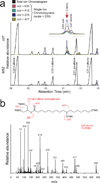The identification of cutin synthase: formation of the plant polyester cutin
- PMID: 22610035
- PMCID: PMC3434877
- DOI: 10.1038/nchembio.960
The identification of cutin synthase: formation of the plant polyester cutin
Abstract
A hydrophobic cuticle consisting of waxes and the polyester cutin covers the aerial epidermis of all land plants, providing essential protection from desiccation and other stresses. We have determined the enzymatic basis of cutin polymerization through characterization of a tomato extracellular acyltransferase, CD1, and its substrate, 2-mono(10,16-dihydroxyhexadecanoyl)glycerol. CD1 has in vitro polyester synthesis activity and is required for cutin accumulation in vivo, indicating that it is a cutin synthase.
Figures



Comment in
-
Plants: Knitting a polyester skin.Nat Chem Biol. 2012 Jun 18;8(7):603-4. doi: 10.1038/nchembio.1004. Nat Chem Biol. 2012. PMID: 22710305 No abstract available.
References
-
- Edwards D. Cells and tissues in the vegetative sporophytes of early land plants. New Phytol. 1993;125:225–247. - PubMed
-
- Nawrath C. Unraveling the complex network of cuticular structure and function. Curr. Opin. Plant Biol. 2006;9:281–287. - PubMed
-
- Heredia A, Heredia-Guerrero JA, Dominguez E, Benitez JJ. Cutin synthesis: A slippery paradigm. Biointerphases. 2009;4:P1–P3. - PubMed
-
- Pollard M, Beisson F, Li Y, Ohlrogge JB. Building lipid barriers: biosynthesis of cutin and suberin. Trends Plant Sci. 2008;13:236–246. - PubMed
-
- Isaacson T, et al. Cutin deficiency in the tomato fruit cuticle consistently affects resistance to microbial infection and biomechanical properties, but not transpirational water loss. Plant J. 2009;60:363–377. - PubMed
Publication types
MeSH terms
Substances
Associated data
- Actions
- PubChem-Substance/135659537
Grants and funding
LinkOut - more resources
Full Text Sources
Other Literature Sources

